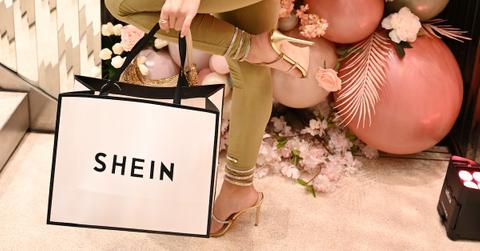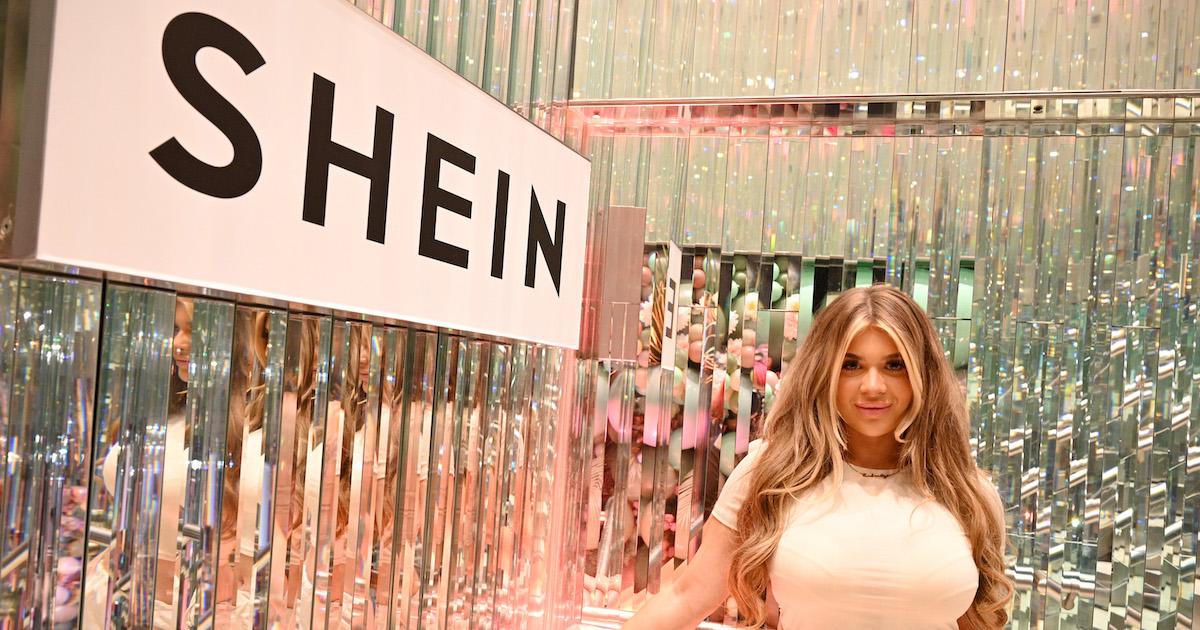Shein May Charge You Low Prices — but the Fast Fashion Brand's Laborers Are Paying
Updated July 24 2023, 1:34 p.m. ET

Danica Taylor attends the launch of the Shein pop-up shop on March 23, 2023 in Birmingham, England.
When browsing fast fashion brands' websites and stores, shoppers might feel compelled to excitedly exclaim "OMG, how is it so cheap?!" every time they notice yet another low price tag.
This is especially true when it comes to shopping from the brand Shein, which often sells clothing items for even cheaper than you'd find them at your local thrift store. But considering Shein made $100 billion in sales in 2022, why is Shein so cheap?
Unfortunately, the answer is not a very pretty one, as it involves the exploitation of laborers and the environment — and therefore, Shein's customers themselves, since we all live on the same planet. By cutting corners at the expense of its laborers and the Earth, Shein is able to charge its customers wickedly low prices, while those who serve the brand's factories pay.
Keep reading more to learn about exactly what makes Shein's clothes so cheap.

Liberty Poolex attends the launch of the Shein pop-up shop on March 23, 2023 in Birmingham, England.
Why is Shein so cheap?
Shein is a fast fashion brand, meaning it is all about producing clothing as cheaply, quickly, and frequently as possible, in order to keep up with constantly-changing fashion trends.
Shein adds thousands of new styles to its website every single day, according to Rest of World. And during the first four months of 2022 alone, Shein reportedly added 314,877 new styles to its U.S. website, according to the Changing Markets Foundation's December 2022 report Synthetics Anonymous 2.0.
Just a quick scroll on Shein's website (I didn't order anything while doing research for this, I swear!) shows dresses for under $5, tops for under $2, and bathing suit pieces for under $3.
Many other major clothing brands also follow the fast fashion model, such as boohoo, PrettyLittleThing, H&M, Zara, Fashion Nova, and Cider. But over the last few years, Shein has become one of the biggest fast fashion companies in the U.S., as per Bloomberg Second Measure.
So how exactly do the folks at Shein make their clothes at such low prices? It comes down to Shein ignoring how the production of its clothing impacts both people and the environment — because if the leaders at Shein did truly care about that, they'd have to either raise prices or sacrifice their massive profits.
Shein reportedly employs cheap labor practices, ignoring its own code of conduct.
Shein makes all of its clothes in China, which is where the company was founded. Most Shein customers live overseas from China, and the brand ships all its products to its international customers in more than 200 countries, via a fully digital supply chain.
In October 2022, the U.K.'s Channel 4 released a documentary called Untold: Inside the Shein Machine, which features hidden camera footage taken inside two of Shein's factories, both located in Guangzhou, China. Hosted by video journalist Iman Amrani, this investigation of Shein made a number of startling discoveries about the brand.
According to The Cut, in the documentary, workers in both Shein factories were observed working days as long as 18 hours, with just one day off per month. The base salary in one factory was just 4,000 yuan each month (about $582 USD, as of publication); and in the other factory, laborers were paid per garment, receiving about 0.27 yuan (which is less than 4 cents) for each item made, as noted by Business Insider.
And in one factory, workers who made mistakes on just one clothing item were seen being docked about two-thirds of their daily pay.
By paying its factory workers such low wages, Shein is able to sell its clothing for astoundingly low prices. Basically, even though you didn't pay much for your $2 tank top, someone did.

Manrika Khaira attends the launch of the Shein pop-up shop on March 23, 2023 in Birmingham, England.
Shein claims to employ ethical labor, but undercover reports find otherwise.
In response to the documentary, a spokesperson for Shein told Business Insider that the company follows International Labor Organization conventions, as well as local laws when it comes to labor practices, and that it conducts unannounced audits at supplier factories.
"Any non-compliance with this code is dealt with swiftly, and we will terminate partnerships that do not meet our standards," Shein told Business Insider in a statement, adding that Shein requested more information from Channel 4 in order to further investigate.
This Channel 4 documentary was reportedly the first time undercover cameras were used to expose unfair working conditions in Shein's factories — but before it was released, there were many other reports of similarly bad conditions.
For instance, in November 2021, Public Eye published an investigation into Shein's factories. The Switzerland-based organization worked with a workers’ rights organization from in South China to send researchers to investigate various factories that supply Shein in China.
There, the anonymous investigative researcher Public Eye employed found evidence of large bags of clothing blocking hallways and stairways, blocking exits in case of fire; zero visible emergency exits; and barred windows on upper floors. Many employees were observed working 75-hour work weeks (which is illegal in China), with no contracts and criminally low pay, they found.
Cutting corners in terms of worker safety and wages allows Shein to turn a profit, all while selling its clothing for cheap.
Shein's website features a Supply Chain Transparency Statement as well as a Supplier Code of Conduct. These pages state that "employment must be voluntary" and legal, all employees must be at least 16, that working hours must comply with local laws, and more. However, Shein provides no evidence that it and its suppliers are actually held responsible for maintaining these standards.
Lawsuits against Shein provide more insight into why Shein is so cheap.
Shein has been the subject of multiple lawsuits. In one, filed in July 2023, three artists sued Shein, accusing the fast fashion giant of stealing their designs, and violating the U.S. federal anti-racketeering act (RICO).
So by allegedly copying designs rather than hiring designers (at least, in the place of the items in question), Shein is able to save money, and therefore charge lower prices.
Shein is bad for the environment.
Another way Shein reduces costs is by ignoring the environmental impact of its clothing production. For one thing, the brand makes everything in China, overseas from where most of its customers live, and sends it internationally via ships and cargo planes, adding to the environmental footprint of a Shein order. Most of Shein's website views come from the U.S. (about 30 percent), Brazil (about 13 percent), and Germany (4 percent), as per Semrush.
And if you've ever watched a "Shein haul" on social media, you know that Shein packages every single item in its own plastic bag. But more environmentally ruinous than the throwaway packaging is the fact that Shein's clothes are essentially designed to be throwaway garments.
Additionally, the clothes are often made from unsustainable materials, like virgin polyester, which is one of the cheapest fabrics out there — and it's also one of the most environmentally-unfriendly ones, as it's made from fossil fuels.
The 2022 report Synthetics Anonymous 2.0 found that Shein's vast use of virgin polyester uses the same amount of CO2 as about 180 coal-fired power plants, as per TIME. This means that each year, Shein emits around 6.3 million tons of CO2.
Shein also does not provide evidence about any efforts to significantly reduce textile waste, use environmentally-friendly dyes, or anything else of the like.
Shein does have some sustainability goals — but no evidence that it's adhering to them.
On Shein's website, the brand claims to "support" all 17 of the UN's Sustainable Development Goals, without any evidence of how it's doing that.
Shein also has a "Protecting the Environment" section on its website, where it acknowledges the need to make the fashion industry more sustainable. Shein claims that it works to "limit excess inventory, reducing the possibility of production waste," and that the brand "attempt[s] to sell unsold or returned inventory at wholesale pricing before donating it to populations in need."
Shein also states that it has invested in "costlier thermal digital transfer and digital direct printing technologies in an effort to reduce water use throughout the production process of Shein-branded items."
While these are all nice claims to make, they appear to be greenwashing, as no one is legally holding Shein accountable to follow through with these promises. And even if these claims are true, it's impossible for a brand to be even a tiny bit eco-friendly brand when it's churning out this many polyester garments at such cheap prices every day.
And in October 2022, Shein launched its own peer-to-peer resale platform called Shein Exchange, which allows customers to sell used Shein clothing to each other.
"At Shein, we believe that it is our responsibility to build a future of fashion that is equitable for all, while also accelerating solutions to reduce textile waste,'' Adam Whinston, Global Head of ESG at Shein, stated at the time.
If Shein really wants to reduce textile waste and build an equitable future of fashion, as Whinston stated, Shein should be taking on this responsibility itself, instead of putting the responsibility on the customer to rehome old Shein clothing.
When asked how Shein keeps its prices so cheap, a spokesperson for Shein tells Green Matters on April 4, 2023:
"Shein’s unique on-demand business model enables us to reduce the waste and overproduction typically associated with the fashion industry by producing an ultra-small batch of each style on our site (as few as 100 pieces), gauging market response, and then communicating this feedback with supplier partners almost immediately. As a result, we only respond with larger production to meet demand if it’s warranted, reducing the unsold inventory percentage to single digits (versus an industry average of 25-40 percent). This leads to cost savings which are passed on to our consumers through our affordable pricing. Shein complies with local laws and regulations in the markets in which it operates."
While these efforts may reduce some waste, it is not enough to counteract Shein's overproduction of clothing or violation of local labor laws, for which evidence abounds.
Overall, if Shein wants to truly do better for the planet, its laborers, and its customers, it would need to start paying living wages, actually following labor laws, taking responsibility for its own textile waste, using more sustainable materials, and so much more. But if Shein did that, the company would have to charge more for its clothing — and then Shein wouldn't be Shein. But maybe that wouldn't be such a bad thing.
This article, originally published on April 4, 2023, has been updated.
